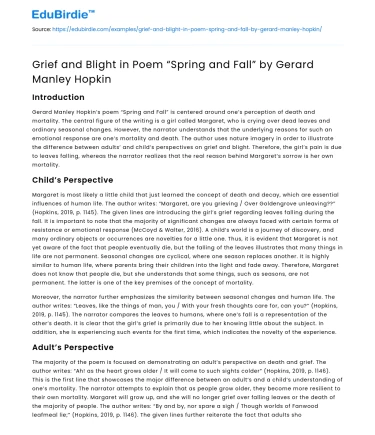Introduction
Gerard Manley Hopkin’s poem “Spring and Fall” is centered around one’s perception of death and mortality. The central figure of the writing is a girl called Margaret, who is crying over dead leaves and ordinary seasonal changes. However, the narrator understands that the underlying reasons for such an emotional response are one’s mortality and death. The author uses nature imagery in order to illustrate the difference between adults’ and child’s perspectives on grief and blight. Therefore, the girl’s pain is due to leaves falling, whereas the narrator realizes that the real reason behind Margaret’s sorrow is her own mortality.
Child’s Perspective
Margaret is most likely a little child that just learned the concept of death and decay, which are essential influences of human life. The author writes: “Margaret, are you grieving / Over Goldengrove unleaving??” (Hopkins, 2019, p. 1145). The given lines are introducing the girl’s grief regarding leaves falling during the fall. It is important to note that the majority of significant changes are always faced with certain forms of resistance or emotional response (McCoyd & Walter, 2016). A child’s world is a journey of discovery, and many ordinary objects or occurrences are novelties for a little one. Thus, it is evident that Margaret is not yet aware of the fact that people eventually die, but the falling of the leaves illustrates that many things in life are not permanent. Seasonal changes are cyclical, where one season replaces another. It is highly similar to human life, where parents bring their children into the light and fade away. Therefore, Margaret does not know that people die, but she understands that some things, such as seasons, are not permanent. The latter is one of the key premises of the concept of mortality.
Save your time!
We can take care of your essay
- Proper editing and formatting
- Free revision, title page, and bibliography
- Flexible prices and money-back guarantee
Moreover, the narrator further emphasizes the similarity between seasonal changes and human life. The author writes: “Leaves, like the things of man, you / With your fresh thoughts care for, can you?” (Hopkins, 2019, p. 1145). The narrator compares the leaves to humans, where one’s fall is a representation of the other’s death. It is clear that the girl’s grief is primarily due to her knowing little about the subject. In addition, she is experiencing such events for the first time, which indicates the novelty of the experience.
Adult’s Perspective
The majority of the poem is focused on demonstrating an adult’s perspective on death and grief. The author writes: “Ah! as the heart grows older / It will come to such sights colder” (Hopkins, 2019, p. 1146). This is the first line that showcases the major difference between an adult’s and a child’s understanding of one’s mortality. The narrator attempts to explain that as people grow older, they become more resilient to their own mortality. Margaret will grow up, and she will no longer grief over falling leaves or the death of the majority of people. The author writes: “By and by, nor spare a sigh / Though worlds of Fanwood leafmeal lie;” (Hopkins, 2019, p. 1146). The given lines further reiterate the fact that adults show little care about the “leafmeal” of dead people. The narrator is trying to explain that Margaret will stop grieving over most people, who will always be dying similarly to leaves falling. The author also writes: “And yet you will weep to know why” (Hopkins, 2019, p. 1146). However, the narrator does not state that adults do not experience grief at all because they do on specific occasions. All people grief when their loved ones pass away, that is why, the line says that one will weep, but the reasons will be clear.
Underlying Reasons
Moreover, the poem also provides similar points between the adult’s and child’s sorrows. The author further writes: “Now no matter, child, the name: / Sorrow’s springs are the same” (Hopkins, 2019, p. 1146). The narrator makes a final comparison and shows the similarity between a child’s and adult’s perspectives, where both express such an emotional response in order to grief. The reasons or “springs” for one’s grief are the same for both adult and child, but the only difference is the fact that the former realizes the underlying reasons. The author writes: “Nor mouth had, no nor mind, expressed / What heart heard of, ghost guessed:” (Hopkins, 2019, p. 1146). The narrator comes back to the current situation of Margaret crying over falling leaves and states that she is not capable of articulating her sorrow. However, it is evident that she is doing so due to the visceral level of understanding or “gut-feeling” without logical comprehension.
The narrator finally elaborates on the actual reason behind Margaret’s grief. The author writes: “It is the blight man was born for, / It is Margaret you mourn for” (Hopkins, 2019, p. 1146). This references the fact that all people are mortal, and so is Margaret. The child’s grief was triggered by the leaves, but the key underlying reason is her own mortality. Margaret unknowingly expresses the correct emotional response to the concept, but the subject and context are not worth crying over. Both blight and decay are inevitable stages that come after the termination of human life. People are born to eventually die and become a decaying blight.






 Stuck on your essay?
Stuck on your essay?

